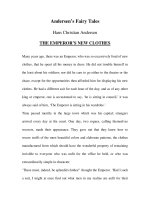THE LEADER''S NEW WORK
Bạn đang xem bản rút gọn của tài liệu. Xem và tải ngay bản đầy đủ của tài liệu tại đây (249.43 KB, 22 trang )
17. září 2004
314 ze 412
18
THE LEADER'S
NEW WORK
WHAT DOES IT TAKE TO LEAD
A LEARNING ORGANIZATION?
"I talk with people all over the country about learning organizations
and 'metanoia,' and the response is always very positive," says
Hanover's Bill O'Brien. "If this type of organization is so widely
preferred, why don't people create such organizations? I think the
answer is leadership. People have no real comprehension of the type of
commitment it requires to build such an organization."
Learning organizations demand a new view of leadership. My col-
league, organizational consultant Charles Kiefer, tells a story of
working with a product development team whose members became
committed to a shared vision of a dramatic new product, which they
eventually brought to market in one third the normal time required.
"Once the vision of the product and how they would develop it
began to crystallize," says Kiefer, "the team began to work in an
extraordinary way. The energy and enthusiasm were palpable. Each
individual felt a genuine sense of responsibility for bow the team as a
17. září 2004
315 ze 412
whole functioned, not just for 'doing his part.' Openness to new
ideas
shifted dramatically and technical problems that had been blocking
their progress began to get solved.
"But a new problem emerged. The prevailing leadership style in the
organization was the traditional style—clear directions and well-
intentioned manipulation to get people to work together toward com-
mon goals. The team leader recognized that the skills and behaviors
that had made him an effective leader in the past would now be
counterproductive. People
with
a sense of their own vision and com-
mitment would naturally reject efforts of a leader to 'get them com-
mitted.' He literally did not know what to do, now that he had a self-
directed team with a clear vision, that was learning how to learn
together."
Our traditional views of leaders—as special people who set the
direction, make the key decisions, and energize the troops—are
deeply rooted in an individualistic and nonsystemic worldview.
Especially in the West, leaders are
heroes
—great men (and occasionally
women) who "rise to the fore" in times of crises. Our prevailing
leadership myths are still captured by the image of the captain of the
cavalry leading the charge to rescue the settlers from the attacking
Indians. So long as such myths prevail, they reinforce a focus on
short-term events and charismatic heroes rather than on systemic
forces and collective learning. At its heart, the traditional view of
leadership is based on assumptions of people's powerlessness, their
lack of personal vision and inability to master the forces of change,
deficits which can be remedied only by a few great leaders.
The new view of leadership in learning organizations centers on
subtler and more important tasks. In a learning organization, leaders
are designers, stewards, and teachers. They are responsible for
building organizations
where people continually expand their capabilities
to understand complexity, clarify vision, and improve shared mental
models—that is, they are responsible for learning.
This new view is vital. When all is said and done, learning organi-
zations will remain a "good idea," an intriguing but distant vision
until people take a stand for building such organizations. Taking this
stand is the first leadership act, the start of
inspiring
(literally "to
breathe life into") the vision of learning organizations. In the absence
of this stand, the learning disciplines remain mere collections of tools
and technique—means of solving problems rather than creating
something genuinely new.
17. září 2004
316 ze 412
LEADER AS DESIGNER
Imagine that your organization is an ocean liner, and that you are
"the leader." What is your role?
I have asked this question of groups of managers many times. The
most common answer, not surprisingly, is "the captain." Others
say, "The navigator, setting the direction." Still others say, "The
helmsman, actually controlling the direction," or "the engineer
down there stoking the fire, providing energy," or, "the social director,
making sure everybody's enrolled, involved, and communicating."
While these are legitimate leadership roles, there is another which, in
many ways, eclipses them all in importance. Yet, rarely does anyone
think of it.
The neglected leadership role is the designer of the ship. No one has a
more sweeping influence than the designer. What good does it do for
the captain to say, "Turn starboard thirty degrees," when the designer
has built a rudder that will turn only to port, or which takes six hours
to turn to starboard? It's fruitless to be the leader in an organization
that is poorly designed. Isn't it interesting that so few managers think
of the ship's designer when they think of the leader's role?
Although "leader as designer" is neglected today, it touches a chord
that goes back thousands of years. To paraphrase Lao-tzu, the bad
leader is he who the people despise. The good leader is he who the
people praise. The great leader is he who the people say, "We did it
ourselves."
Lao-tzu also illuminates part of the reason why design is a ne-
glected dimension of leadership: little credit goes to the designer. The
functions of design are rarely visible; they take place behind the scenes.
The consequences that appear today are the result of work done long
in the past, and work today will show its benefits far in the future.
Those who aspire to lead out of a desire to control, or gain fame, or
simply to be "at the center of the action" will find little to attract them
to the quiet design work of leadership. Not that this type of
leadership is without its rewards. Those who practice it find deep
satisfaction in empowering others and being part of an organization
capable of producing results that people truly care about. In fact, they
find these rewards more enduring than the power and praise granted
to traditional leaders.
For example, consider the role of systems thinking in a leader's
17. září 2004
317 ze 412
work. Joanne, the president of a new
division that
is growing
rapidly,
recognizes a limits
to growth structure
that could
undermine
continuing
growth: as the number of managers in the new division grows, the
diversity of management styles will increase, undermining the
coherence of vision and operating values that has made the division a
success to date. The "limiting factor" will be the division's capacity to
assimilate new managers. Rather than waiting for the problem to arise
and then dealing with it, Joanne develops a selection and self-
assessment process that helps new managers understand the current
vision and values and see if their own style is compatible; and she
allocates a significant portion of her own time to working with new
managers. The result is continuing growth of the division. Given our
normal "leader as hero" viewpoint, this is not leadership. There is no
crisis—in fact, there isn't even a problem that gets solved. The
"problem" of inconsistency in values and vision simply never develops;
it wasn't "solved," it was "dissolved." This is the hallmark of effective
design.
As this story illustrates, the design work of leaders includes designing
an organization's policies, strategies, and "systems." But it goes
beyond that. Designing policies and strategies that no one can
implement because they don't understand or agree with the thinking
behind them has little effect. To appreciate the new view of "leader as
designer," let's return to the DC-3.
The critical design function, without which the DC-3 would never
have succeeded, involved integrating the five component technologies. For
example, designing the engine specifications required understanding
the effects of the variable pitch propellers, the wing flaps, the
retractable landing gear, as well as the stress characteristics of the new
monocoque body. So, too, did the wing and body design depend on
the engine's thrust. The task of integrating the component
technologies was more critical to the success of the DC-3 than the
task of designing any single component.
Design is, by its nature, an integrative science because design requires
making something work in practice. "We would not consider a car well
designed," says Herman Miller's Ed Simon, "if it had the best
transmission, the best seats, and the best engine, but was terrible to
ride in and impossible to control on wet roads. The essence of design
is seeing how the parts fit together to perform as a whole."
So too does the crucial design work for leaders of learning organi-
zations concern integration. As background for this chapter I inter-
17. září 2004
318 ze 412
viewed three leaders who have been part of our MIT research
program for several years, Simon, Bill O'Brien of Hanover Insurance,
and Ray Stata of Analog Devices. Each pointed to design as a critical
function of leadership and each saw design as an integrative task. "The
new job description of leaders," according to Stata, "will involve design
of the organization and its policies. This will require seeing the
company as a system in which the parts are not only internally
connected, but also connected to the external environment, and
clarifying how the whole system can work better." Or as Simon put it,
"We need a new generation of organizational architects. But to get
there we must first correct basic misunderstandings about the nature
of business design. It's not just rearranging the organization structure.
We have to get away from the P&L statement and design for the long
term—based on understanding interdepen-dencies. Most changes in
organization structure are piecemeal reactions to problems. Real
designers are continually trying to understand wholes."
Just as the DC-3 designers had to integrate the five component
technologies, crucial design work for leaders of learning organization
concerns integrating vision, values, and purpose, systems thinking,
and mental models—or more broadly, integrating all the learning
disciplines. It is the synergy of the disciplines that can propel an
organization to major breakthroughs in learning. As best we can tell so
far,
all
the disciplines are critical and must be developed. Leaders must
guard against slipping into a comfortable "groove" of relying on
particular disciplines, each of which, in isolation, will prove self-
limiting. This is why organizations that get fired up by vision can
become "vision junkies," just as organizations that come to "believe
in" systems thinking as the answer to life's problems will reach
diminishing returns in their ongoing systems analyses.
This does not mean that all the disciplines must be developed
simultaneously. Though all are important, there are crucial questions
concerning sequencing and interactions among the disciplines. What
disciplines should be developed first? How can understanding in one
area lead to mastery in another? How do we sustain movement along all
critical dimensions and not become self-satisfied with our accom-
plishments in one area? These are the types of design questions that
leaders must ponder.
Most of the leaders with whom I have worked agree that the first
leadership design task concerns developing vision, values, and purpose
or mission. "Organization design is widely misconstrued as
17. září 2004
319 ze 412
moving around boxes and lines," says Bill O'Brien. "The first task
of organizational design concerns designing the governing ideas—
the
purpose, vision, and core values by which people will live." "Designing
the organization as a whole," says Stata, "includes the intangibles of
even the more subtle values that knit things together."
Building shared vision is important early on because it fosters a
longer-term orientation and an imperative for learning. Systems
thinking is also important early on because managers are inherently
pragmatic and need insights into "current reality" as well as a picture
of the future toward which they are moving. Some understanding of
mental models and the basics of bringing underlying assumptions
to the surface is also important early on. Introducing conceptual tools
such as systems thinking in isolation from learning how to work with
mental models, both individually and in teams, often proves
disappointing. Managers believe that the purpose is to figure out the
"system out there," not to discover inconsistencies in their own ways
of thinking.
Personal mastery is often one of the later disciplines to emphasize
because managers are often, justifiably, cautious in overemphasizing
personal growth. Freedom of individual choice is critical in any or-
ganization effort to foster personal mastery. As already discussed,
what matters most is the visible behavior of people in leadership
positions in sharing their own personal visions and demonstrating
their commitment to the truth.
These statements are broad guidelines at best. The art of leadership
involves sizing up the players and needs in each situation and crafting
strategies suitable to the time and setting. For example, some
organizations have a high ethic of collaboration, which makes them
especially receptive to team learning and shared vision. Yet, in the
same organization, people might have difficulties with systems
thinking, which they might see as confronting established mental
models and operating policies. In a large organization, different com-
binations of learning disciplines will be developing in different oper-
ating units; and leadership is operating at many levels, from local
leaders who are bringing the disciplines to bear on current problems, to
central leaders who are addressing global issues and organization-wide
learning processes.
Even the criteria that you'd bring to bear in making these choices
are not yet certain. Do you start with the "easiest disciplines," that is,
the disciplines where there is the greatest readiness and least
resistance? In general, I find people eager to master new learning
17. září 2004
320 ze 412
disciplines so long as they can connect
those skills to important
problems and personal learning needs. But if there is resistance
to
certain disciplines, do you push or do you hold off until you have
built up momentum in another area?
Generally, I would counsel against pushing. Usually it is more
effective to look for the source of the resistance, either in perceived
lack of relevance, fear of failure (i.e., "I won't be competent in
the
new discipline"—remember we were all schoolchildren once), or
perceived threat to the status quo. The leaders who fare best are
those who continually see themselves as designers not crusaders.
Many of the best intentioned efforts to foster new learning disciplines
founder because those leading the charge forget the first rule of
learning: people learn what they need to learn, not what someone else
thinks they need to learn.
In essence, the
leaders' task is designing the learning processes
whereby
people throughout the organization can deal productively with the
critical issues they face, and develop their mastery in the learning
disciplines. This is new work for most experienced managers, many of
whom rose to the top because of their decision-making and
problem-solving skills, not their skills in mentoring, coaching, and
helping others learn. But, as Ed Simon says, this is no reason to turn
back: "There is much that we do not know about what will be
required to build learning organizations, but one thing is certain—
there is
new work
here, and we must be willing to abandon our whole
paradigm of who we are as managers to master this new work."
LEADER AS STEWARD
The interviews that I conducted as background for this chapter led
to what was, for me, a surprising discovery. Although the three
leaders with whom I talked operate in completely different industries —
a traditional service business, a traditional manufacturing business,
and a high-tech manufacturing business—and although the specifics of
their views differed substantially, they each appeared to draw their
own inspiration from the same source. Each perceived a deep story
and sense of purpose that lay behind his vision, what we have come to
call the
purpose story
—a larger "pattern of becoming" that gives unique
meaning to his personal aspirations and his
hopes
for their
organization.
For O'Brien the
story has
to do with "the
17. září 2004
321 ze 412
ascent of man." For Ed Simon,
it has to do with "living in a more
creative orientation." For Ray Stata, it has to do "with integrating
thinking and doing."
This realization came late one evening, after a very long day with
the tape and transcript of one of the interviews. I began to see that
these leaders were doing something different from just "story telling,"
in the sense of using stories to teach lessons or transmit bits of
wisdom. They were relating
the
story—the overarching explanation of
why they do what they do, how their organization needs to evolve, and
how that evolution is part of something larger. As I reflected back
on gifted leaders whom I have known, I realized that this "larger
story" was common to them all, and conversely that many otherwise
competent managers in leadership positions were not leaders of the
same ilk precisely because they saw no larger story.
The leader's purpose story is both personal and universal. It de-
fines her or his life's work. It enobles his efforts, yet leaves an
abiding humility that keeps him from taking his own successes and
failures too seriously. It brings a unique depth of meaning to his
vision, a larger landscape upon which his personal dreams and goals
stand out as landmarks on a longer journey. But what is most impor-
tant, this story is central to his
ability to lead.
It places his organization's
purpose, its reason for being, within a context of "where we've
come from and where we're headed," where the "we" goes beyond the
organization itself to humankind more broadly. In this sense, they
naturally see their organization as a vehicle for bringing learning and
change into society. This is the power of the purpose story—it
provides a single integrating set of ideas that gives meaning to all
aspects of the leader's work.
Out of this deeper story and sense of purpose or destiny, the leader
develops a unique relationship to his or her own personal vision. He or
she becomes a
steward
of the vision.
The best way to appreciate the "leader as steward" in the context of
building learning organizations is to see the way individuals committed
to such work describe their own sense of purpose. The following are
excerpts from my interviews:
Bill O'Brien
President
and CEO, Hanover Insurance
PMS
:
Bill, why are there such pressures for change in management
today—is it primarily because of competitive pressures?









